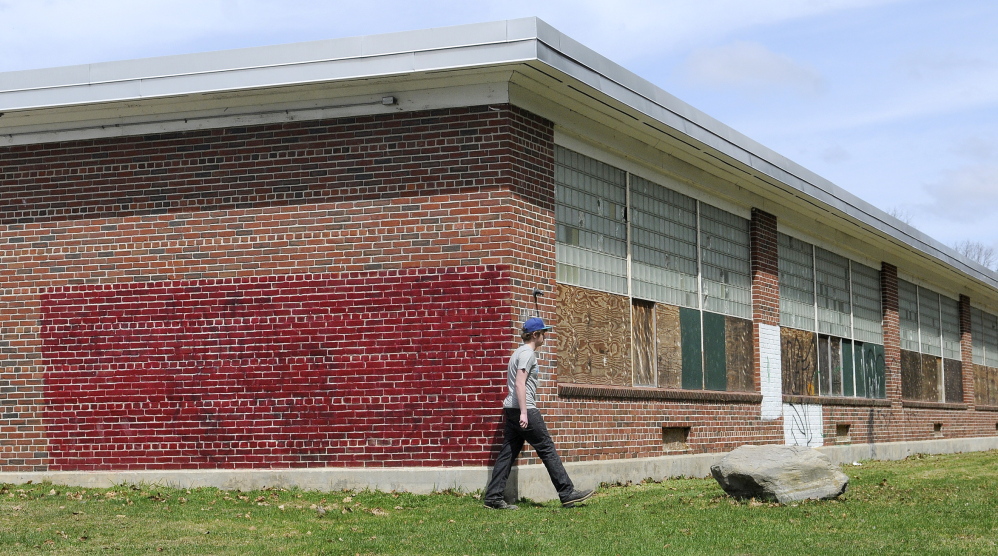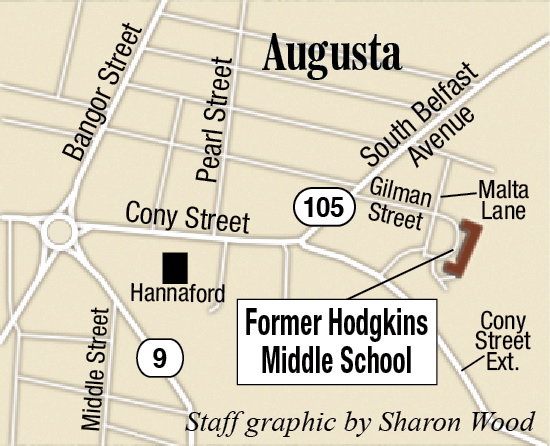AUGUSTA — An Augusta Housing Authority proposal to renovate the former Hodgkins Middle School into housing for the elderly cleared a major hurdle this week when the project was selected to receive low-income housing tax credits expected to generate about $6 million.
Amanda Bartlett, the housing authority’s executive director, said the organization’s plan to convert the former middle school into 47 apartments for low-income senior citizens would be funded entirely by tax credit equity.
“The ability for Hodgkins to be converted to senior housing lives and dies with this tax credit award,” Bartlett said. “If it weren’t awarded, this project would be unable to move forward. It’s huge.”
The total cost of turning the vacant school into housing is estimated at $8.7 million. Bartlett said the authority is seeking state and federal historic preservation tax credits to cover the remaining $2.7 million of the cost.
Low-income housing tax credits are meant to encourage the creation of low-income housing by selling tax credits to investors, generally businesses or banks, which they use to write off a portion of their taxes. The proceeds from those sales of tax credits then go to housing projects, in this case the Hodgkins project.
Each year MaineHousing gets an allotment of tax credits to encourage development of low-income housing, and there is a competitive process for that tax credit funding. Bartlett said the Augusta project is one of only six housing development applicants statewide to be awarded tax credits by MaineHousing for 2015 out of 15 that applied. She said Augusta’s application was the top-scoring project in the state.
Deborah Turcotte, public information manager for MaineHousing, confirmed Augusta’s application was the highest-scoring project this year. The scoring system considers factors such as a project’s affordability and proximity to services and transportation.
“Why this one scored so high was because it was a very solid application,” Turcotte said. “Augusta Housing knew the need, had the building and submitted an application that warranted a high score.”
Turcotte said this year Maine is getting about $3.4 million in federal tax credits, which is expected to leverage another $26 million to $30 million in private investment.
“It’s a win for Maine and other states,” Turcotte said of the tax credit program. “It’s bringing a tremendous amount of investment into affordable housing and construction, which means affordable housing for people who need it and (construction) jobs.”
The Augusta Housing Authority is working on the project with developer Kevin Bunker, of Portland-based Developers Collaborative, who has experience in converting old Maine schools into housing.
Hodgkins, which closed as a school at the end of the 2009 school year in a cost-cutting move, is in a residential neighborhood on Malta Street, just off Cony Street. Augusta public school students in grades seven and eight now attend classes at Cony High School. The School Department turned the Hodgkins building over to the city after it closed as a school. It has been vacant and unheated in the years since then.
In May, city councilors approved a 90-year lease of Hodgkins to the Augusta Housing Authority for the project.
“It’s awesome because when I came on board a year ago, we knew housing was a huge issue in Augusta,” Bartlett said. “Right now we have a lack of safe, affordable housing. For us to be able to pull this together with the city’s support to make this happen in a year’s time is huge. The city bent over backwards to help make this happen.”
The city would receive only $1 a year under the terms of the lease, but officials have noted that by striking a deal to have the building converted to provide needed housing, the city avoids the costs of maintaining, renovating or demolishing the building, which has mold on some walls, asbestos in parts of its floor and a leaky roof.
The housing authority, not the city, will be responsible for maintaining the building. Bartlett said an environmental assessment of the building would be performed as part of its conversion to a new use.
Bunker previously noted that having to remove asbestos and take other steps to make older buildings ready and safe for new uses is common in such projects.
Bunker has been involved in other former school building developments, including the development of housing at Gilman School in Waterville, Emery School in Biddeford and more recently Nathan Clifford School in Portland.
Bartlett said the next step will be working with an architect to finalize design plans, which could take a few months. She said the plan calls for construction to start in April or May, and the building would re-open in mid-2016.
The 30,575-square-foot building was built in 1958.
The city has retained a right of way to ballfields next to the building.
A rental housing market study done in 2013 in preparation for the renovation of the old Cony flatiron building into housing for senior citizens indicated a need for more rental units to accommodate a projected additional 192 renters over the age of 65 in Augusta between 2013 and 2018.
In March, the city and the Augusta Housing Authority held a community housing forum at which attendees said the city needs more safe, affordable housing, because the rental market had tightened as the creation of new housing had not kept pace with demand and, at the same time, rental units had been lost to code violations and fires.
Keith Edwards — 621-5647
kedwards@centralmaine.com
Twitter: @kedwardskj
Send questions/comments to the editors.





Success. Please wait for the page to reload. If the page does not reload within 5 seconds, please refresh the page.
Enter your email and password to access comments.
Hi, to comment on stories you must . This profile is in addition to your subscription and website login.
Already have a commenting profile? .
Invalid username/password.
Please check your email to confirm and complete your registration.
Only subscribers are eligible to post comments. Please subscribe or login first for digital access. Here’s why.
Use the form below to reset your password. When you've submitted your account email, we will send an email with a reset code.